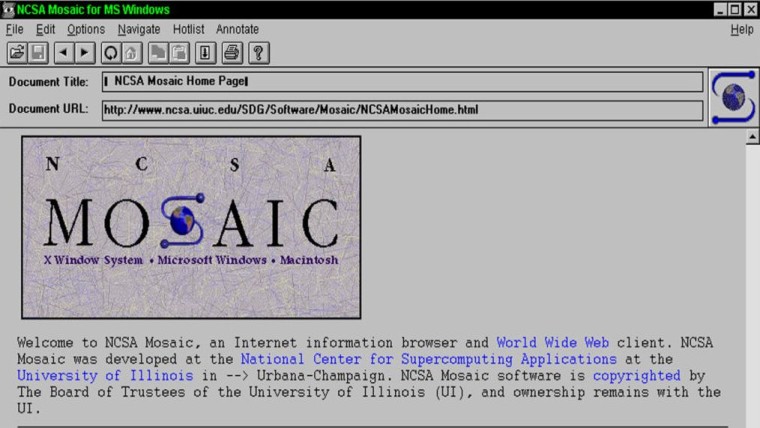It's sometimes difficult to label a product or service that truly changed the world after it was released. However, it definitely can be said that the release of the Mosaic web browser did just that. After a preliminary release in January 1993, version 1.0 of Mosaic was launched 30 years ago this month, on April 22, 1993.
Let's get this part out of the way: Mosaic was not the first web browser ever released. That honor belongs to WorldWideWeb, which was launched a few years before in 1990 by developer Tim Berners-Lee when he worked at CERN. Later other browsers like Viola and Cello were launched. However, Mosaic was different.
The browser was first developed by Marc Andreessen and Eric Bina when they were graduate students at the National Center for Supercomputing Applications (NCSA) at the University of Illinois Urbana-Champaign. Unlike earlier web browsers, which showed text and images in separate windows, Mosaic's biggest innovation was that it was capable of showing both text and images in the same window. It made looking at websites like you were reading a magazine page.

Mosaic also let users click on hyperlinks to go to other pages or sites, instead of manually typing a URL address It had a user interface design that was easy to understand. The now familiar buttons for going back or forward through sites, or refreshing a page, were in place with Mosaic.
While originally launched for Unix systems, Mosaic versions were released later in 1993 for Windows and Macintosh. The need for a closed internet service like AOL, Compuserve, Prodigy, and the other online services that popped up in the 1980s started to slowly go away. All you needed to access the internet was an ISP and Mosaic installed. The NCSA's official Mosaic website states that by December 1993 "more than 5,000 copies of the browser were being downloaded a month and the center was receiving hundreds of thousands of email inquiries a week."
Keep in mind this is an era where most homes could only connect to the internet with a 28.8k phone modem.
Starting in 1994, the US National Science Foundation started funding for further development of Mosaic. However, even then the writing was on the wall for the web browser's shutdown. Later that year, Mosaic's co-creator Marc Andreessen left NCSA and helped to found Mosaic Communications Corporation.
That company released its first browser, called Mosaic Netscape, in late 1994. The NCSA threatened legal action at the new company for using the Mosaic brand for the browser and company. The browser was finally named Netscape Navigator, and the company was renamed Netscape Communications Corporation.
Netscape quickly became the browser of choice for most Internet users, which meant Mosaic was being downloaded and used less and less. As a result, in January 1997, the NCSA shut down the development of the web browser. Of course, Netscape soon had to deal with Microsoft's efforts with its own Internet Explorer browser, but that is a whole different story that we may write about another day. Netscape met its eventual end in 2008.
While the NCSA did shut down its development, the organization continues to be proud of Mosaic. 10 years after its official launch, it held a birthday party of sorts for the browser. Rick Rashid, the founder of Microsoft Research was one of the event's guests.
While Mosaic was ultimately a short-lived computer application, it certainly had a massive influence on the internet in general, and the entire world as a whole. Even in this world of apps and social networks, websites continue to be the primary way we get information online. Mosaic's features of combining words and images on one web page, its use of embedded hyperlinks, and its standard UI are the basics for all web browsers released afterwards. The National Science Foundation's article on Mosaic, posted in 2004, sums up its impact.
"Without Mosaic, Web browsers might not have happened or be what they are today," said Peter Freeman, NSF assistant director for CISE. "The growth of the Web and its impact on daily life shows the kind of dramatic payoff that NSF investments in computer science research can have for all areas of science and engineering, education and society as a whole."
That impact remains true in 2023, and it will likely continue to be felt for years to come.
- alf9872000
-

 1
1




Recommended Comments
There are no comments to display.
Join the conversation
You can post now and register later. If you have an account, sign in now to post with your account.
Note: Your post will require moderator approval before it will be visible.